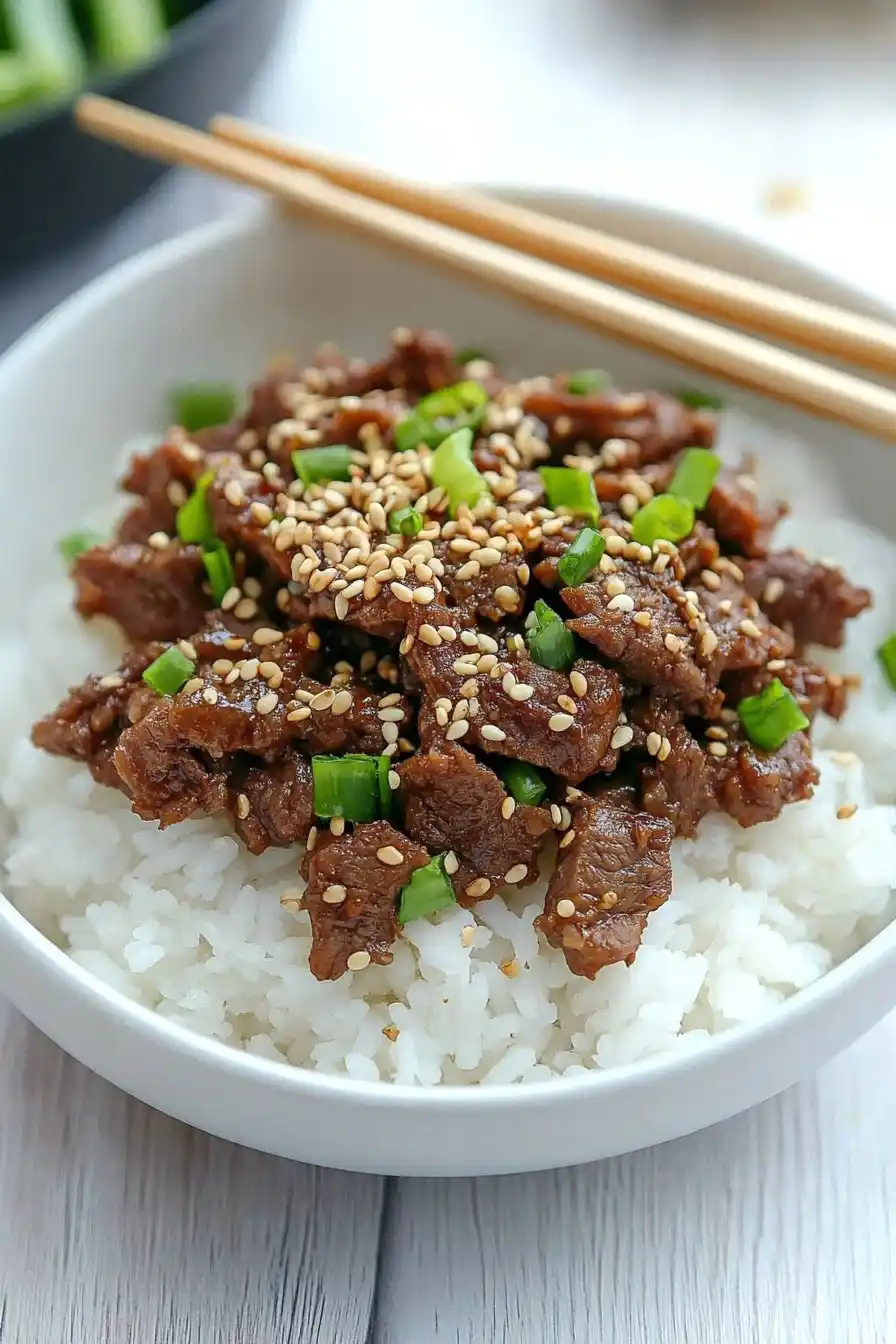Korean beef has always been one of those comfort foods I crave, but following a low FODMAP diet meant I had to get creative in the kitchen. After a few tries (and some interesting results), I finally figured out how to make this classic dish work without triggering any digestive issues.
I know how frustrating it can be to give up your favorite foods when dealing with dietary restrictions. That’s why I love sharing recipes like this one – it proves you don’t have to sacrifice flavor just because you’re following a specific diet. This low FODMAP version uses simple ingredient swaps that keep all the good stuff while leaving out what might upset your stomach.
Want the rich flavors of Korean cuisine without the worry? This recipe has your back. It’s quick enough for weeknight dinners but tastes like you spent hours in the kitchen. Plus, your whole family will love it, whether they’re following a low FODMAP diet or not.

Why You’ll Love This Korean Beef
- Quick preparation – Ready in just 25-35 minutes, this Korean beef is perfect for those busy weeknights when you need a fast but tasty dinner solution.
- FODMAP-friendly – This recipe is specially adapted for those following a low FODMAP diet, using garlic-flavored oil and only the green parts of scallions to keep all the flavor without the digestive discomfort.
- Simple ingredients – Most of these ingredients are pantry staples or easy to find at your local grocery store, making this a convenient go-to meal.
- Versatile serving options – Serve it over rice for a filling meal, or wrap it in lettuce leaves for a lighter, low-carb option – it’s delicious either way!
What Kind of Ground Beef Should I Use?
For Korean beef, you’ll want to use lean ground beef with about 85-90% lean meat to 10-15% fat content. This ratio gives you enough fat to keep the meat juicy and flavorful, but not so much that your dish becomes greasy. Regular ground beef (80/20) can work too, but you might want to drain some of the fat after cooking. If possible, choose freshly ground beef rather than pre-packaged – it typically has better texture and flavor. Just make sure the meat has a bright red color and no grey spots when you’re buying it from the store.

Options for Substitutions
Following a low FODMAP diet doesn’t mean you can’t enjoy this tasty Korean beef! Here are some helpful substitutions:
- Garlic-flavored oil: If you can’t find garlic-flavored oil, make your own by warming regular oil with garlic cloves for 5 minutes, then remove the garlic. You can also use plain olive oil or vegetable oil if needed.
- Minced beef: Ground turkey or pork work well here too. If using turkey, add an extra teaspoon of oil since it’s leaner than beef.
- Brown sugar: You can use maple syrup or regular white sugar instead. Start with a smaller amount and adjust to taste since maple syrup is sweeter.
- Soy sauce: For gluten-free needs, use tamari or coconut aminos. Note that coconut aminos are sweeter, so reduce the brown sugar if using them.
- Fresh ginger: Ground ginger works too – use 1/4 teaspoon as it’s more concentrated than fresh.
- Red chili flakes: Gochugaru (Korean red pepper) is traditional but not always easy to find. Regular chili flakes work fine, or use a dash of sriracha sauce instead.
- White rice: Brown rice, quinoa, or cauliflower rice are good alternatives. Lettuce wraps are great for a low-carb option.
Watch Out for These Mistakes While Cooking
The biggest mistake when cooking Korean beef is overcrowding the pan, which causes the meat to steam instead of brown – work in batches if needed and use a large skillet over medium-high heat to get that perfect caramelization. Getting the sauce consistency right can be tricky, so start with less brown sugar and add more to taste, as the sweetness level can quickly overpower the other flavors. A common error is overcooking the scallion greens – add them at the very end of cooking and just let them wilt slightly to maintain their fresh flavor and crisp texture. For the best results, let your meat come to room temperature before cooking and pat it dry with paper towels to ensure proper browning, and don’t forget to break up any large chunks of meat while it cooks for the most even texture.

What to Serve With Korean Beef?
This savory-sweet Korean beef is super flexible when it comes to serving options! While it’s perfect over a bowl of steamy white rice, you can also serve it wrapped in crisp lettuce leaves for a lighter meal. I like to add some quick pickled vegetables on the side – carrots and cucumbers work great and add a nice crunch. For extra veggie power, try serving it with sautéed baby bok choy or steamed broccoli, which both stay within low FODMAP guidelines. A sprinkle of extra scallion greens and sesame seeds on top gives the dish a nice finishing touch.
Storage Instructions
Keep Fresh: This Low FODMAP Korean beef is perfect for meal prep! Place it in an airtight container and keep it in the fridge for up to 4 days. I like to store the rice separately to maintain the best texture for both components.
Freeze: Got leftovers? This dish freezes really well! Pack the beef mixture in freezer-safe containers or bags and it’ll stay good for up to 3 months. Just remember to leave out any fresh toppings like scallions – you can add those after reheating.
Reheat: When you’re ready to eat, warm up the beef in the microwave for 1-2 minutes, stirring halfway through, or heat it in a pan on the stovetop. Add a splash of water if needed to keep it from drying out. Top with fresh scallions and sesame seeds just before serving for the best flavor.
| Preparation Time | 10-15 minutes |
| Cooking Time | 15-20 minutes |
| Total Time | 25-35 minutes |
| Level of Difficulty | Easy |
Estimated Nutrition
Estimated nutrition for the whole recipe (without optional ingredients):
- Calories: 700-850
- Protein: 50-60 g
- Fat: 40-50 g
- Carbohydrates: 50-60 g
Ingredients
For the beef:
- 1 lb lean minced beef (recommended 90/10 lean for best texture)
- 1 tbsp garlic flavored oil
For the sauce:
- 2 tsp toasted sesame oil
- 1/4 cup soy sauce (low sodium preferred for better control of saltiness)
- 1/2 to 1 tsp crushed red chili flakes (adjust to your preferred spice level)
- 1/4 to 1/2 cup brown sugar (light or dark brown sugar works well)
- 1/2 tsp fresh ginger (finely grated for smooth incorporation)
For the garnish & seasoning:
- toasted sesame seeds, for topping (adds a nutty crunch)
- salt, to taste
- pepper, to taste
- 4 to 6 scallions (green parts only, thinly sliced)
For serving:
- cooked white rice or lettuce leaves (for a low-carb option)
Step 1: Brown the Beef
Heat infused oil in a large skillet over medium heat.
Add the beef to the skillet and brown it completely.
As it cooks, break the beef into smaller pieces using a wooden spoon or spatula.
If there is excess grease, drain it from the skillet to ensure a less oily dish.
Step 2: Make the Sauce
In a small bowl, combine sesame oil, brown sugar, soy sauce, ginger, and red pepper flakes.
Mix these ingredients thoroughly to create a flavorful sauce.
Step 3: Combine Beef and Sauce
Pour the prepared sauce over the browned beef in the skillet.
Allow the mixture to simmer for a few minutes so the beef can absorb the flavors.
Taste the mixture and adjust the seasoning to your preference by adding more sugar or pepper if desired.
Step 4: Final Touches
Remove the skillet from heat and stir in scallion tips for a burst of freshness.
Garnish the dish with sesame seeds to add a crunchy texture and nutty flavor.
Step 5: Serve
Serve the flavorful beef mixture over steamed rice for a hearty meal.
Alternatively, offer it in lettuce leaves or cups for a lighter, refreshing option.
Enjoy your delicious creation!

